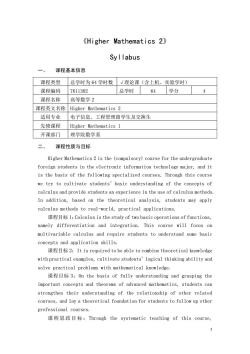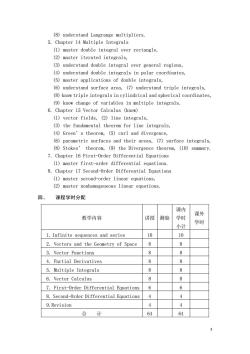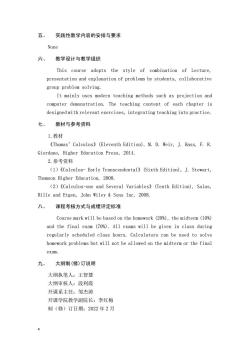北方工业大学:电子信息工程专业留学生《Higher Mathematics 2》高等数学2课程教学大纲 Syllabus

《Higher Mathematics2》 SyI labus 课程基本信息 课程类型 总学时为64学时数√理论课(含上机、实验学时) 课程编码 7611302 总学时64学分 4 课程名称 高等数学2 课程英文名称Higher Mathematics2 适用专业 电子信息、工程管理留学生及交换生 先修课程 Higher Mathematics 1 开课部门理学院数学系 二、 课程性质与目标 Higher Mathematics 2 is the (compulsory)course for the undergraduate foreign students in the electronic information technology major,and it is the basis of the following specialized courses.Through this course we try to cultivate students'basic understanding of the concepts of calculus and provide students an experience in the use of calculus methods. In addition,based on the theoretical analysis,students may apply calculus methods to real-world,practical applications. 课程目标l:Calculus is the study of two basic operations of functions, namely differentiation and integration.This course will focus on multivariable calculus and require students to understand some basic concepts and application skills. 课程目标2:It is required to be able to combine theoretical knowledge with practical examples,cultivate students'logical thinking ability and solve practical problems with mathematical knowledge. 课程目标3:On the basis of fully understanding and grasping the important concepts and theorems of advanced mathematics,students can strengthen their understanding of the relationship of other related courses,and lay a theoretical foundation for students to follow up other professional courses. 课程思政目标:Through the systematic teaching of this course
1 《Higher Mathematics 2》 Syllabus 一、 课程基本信息 课程类型 总学时为 64 学时数 √理论课(含上机、实验学时) 课程编码 7611302 总学时 64 学分 4 课程名称 高等数学 2 课程英文名称 Higher Mathematics 2 适用专业 电子信息、工程管理留学生及交换生 先修课程 Higher Mathematics 1 开课部门 理学院数学系 二、 课程性质与目标 Higher Mathematics 2 is the (compulsory) course for the undergraduate foreign students in the electronic information technology major, and it is the basis of the following specialized courses. Through this course we try to cultivate students’basic understanding of the concepts of calculus and provide students an experience in the use of calculus methods. In addition, based on the theoretical analysis, students may apply calculus methods to real-world, practical applications. 课程目标 1:Calculus is the study of two basic operations of functions, namely differentiation and integration. This course will focus on multivariable calculus and require students to understand some basic concepts and application skills. 课程目标 2:It is required to be able to combine theoretical knowledge with practical examples, cultivate students' logical thinking ability and solve practical problems with mathematical knowledge. 课程目标 3:On the basis of fully understanding and grasping the important concepts and theorems of advanced mathematics, students can strengthen their understanding of the relationship of other related courses, and lay a theoretical foundation for students to follow up other professional courses. 课程思 政目标:Through the systematic teaching of this course

especially how to ask new questions,think and analyze problems,gradually cultivate students'innovative thinking ability and mathematical modeling ability:by revealing the beauty in mathematics,combined with the teaching content,properly explain the scientist's dedication to science stories to strengthen quality education. 三、课程教学基本内容与要求 1.Chapter 10 Infinite sequences and series (1)master sequences,(2)master series, (3)master the integral test and estimates of sum, (4)master comparison tests,(5)master alternating series, (6)understand absolute convergence and the ratio and root test (7)master strategy of for testing series,(8)master power series, (9)understand representation of functions as power series, (10)Taylor and Maclaurin series,(11)The binomial series, (12)Applications of Taylor polynomials. 2.Chapter 11 Vectors and the Geometry of Space (1)master three-dimensional coordinate systems (2)master vectors,(3)master the dot product, (4)master the cross product, (5)master equations of lines and planes, (6)understand cylinders and quadric surfaces, (7)know cylindrical and spherical coordinates. 3.Chapter 12 Vector Functions (1)understand vector functions and space curves, (2)understand derivatives and integrals of vector functions, (3)understand arc length and curvature (4)know motion in space:velocity and acceleration. 4.Chapter 13 Partial Derivatives (1)master functions of several variables, (2)master limits and continuity, (3)master partial derivatives, (4)understand tangent planes and linear approximations, (5)master the chain rule, (6)understand directional derivatives and the gradient vector, (7)master maximum and minimum values
2 especially how to ask new questions, think and analyze problems, gradually cultivate students' innovative thinking ability and mathematical modeling ability; by revealing the beauty in mathematics, combined with the teaching content, properly explain the scientist's dedication to science stories to strengthen quality education. 三、 课程教学基本内容与要求 1. Chapter 10 Infinite sequences and series (1) master sequences, (2) master series, (3) master the integral test and estimates of sum, (4) master comparison tests, (5) master alternating series, (6) understand absolute convergence and the ratio and root test, (7) master strategy of for testing series,(8) master power series, (9) understand representation of functions as power series, (10) Taylor and Maclaurin series, (11) The binomial series, (12) Applications of Taylor polynomials. 2. Chapter 11 Vectors and the Geometry of Space (1) master three-dimensional coordinate systems, (2) master vectors, (3) master the dot product, (4) master the cross product, (5) master equations of lines and planes, (6) understand cylinders and quadric surfaces, (7) know cylindrical and spherical coordinates. 3. Chapter 12 Vector Functions (1) understand vector functions and space curves, (2) understand derivatives and integrals of vector functions, (3) understand arc length and curvature, (4) know motion in space: velocity and acceleration. 4. Chapter 13 Partial Derivatives (1) master functions of several variables, (2) master limits and continuity, (3) master partial derivatives, (4) understand tangent planes and linear approximations, (5) master the chain rule, (6) understand directional derivatives and the gradient vector, (7) master maximum and minimum values

(8)understand Langrange multipliers 5.Chapter 14 Multiple Integrals (1)master double integral over rectangle, (2)master iterated integrals, (3)understand double integral over general regions, (4)understand double integrals in polar coordinates (5)master applications of double integrals (6)understand surface area,(7)understand triple integrals, (8)know triple integrals in cylindrical and spherical coordinates, (9)know change of variables in multiple integrals. 6.Chapter 15 Vector Calculus (know) (1)vector fields.(2)line integrals. (3)the fundamental theorem for line integrals, (4)Green's theorem,(5)curl and divergence, (6)parametric surfaces and their areas,(7)surface integrals, (8)Stokes'theorem,(9)the Divergence theorem,(10)summary. 7.Chapter 16 First-Order Differential Equations (1)master first-order differential equations. 8.Chapter 17 Second-Order Differential Equations (1)master second-order linear equations, (2)master nonhomogeneous linear equations. 四、 课程学时分配 课内 课外 教学内容 讲授 测验 学时 学时 小计 1.Infinite sequences and series 10 10 2.Vectors and the Geometry of Space R 3.Vector Functions 8 4.Partial Derivatives 5.Multiple Integrals 6.Vector Calculus 7.First-Order Differential Equations6 8.Second-Order Differential Equations 9.Revision 合 计 64 64
3 (8) understand Langrange multipliers. 5. Chapter 14 Multiple Integrals (1) master double integral over rectangle, (2) master iterated integrals, (3) understand double integral over general regions, (4) understand double integrals in polar coordinates, (5) master applications of double integrals, (6) understand surface area, (7) understand triple integrals, (8) know triple integrals in cylindrical and spherical coordinates, (9) know change of variables in multiple integrals. 6. Chapter 15 Vector Calculus (know) (1) vector fields, (2) line integrals, (3) the fundamental theorem for line integrals, (4) Green’s theorem, (5) curl and divergence, (6) parametric surfaces and their areas, (7) surface integrals, (8) Stokes’ theorem, (9) the Divergence theorem, (10) summary. 7. Chapter 16 First-Order Differential Equations (1) master first-order differential equations. 8. Chapter 17 Second-Order Differential Equations (1) master second-order linear equations, (2) master nonhomogeneous linear equations. 四、 课程学时分配 教学内容 讲授 测验 课内 学时 小计 课外 学时 1. Infinite sequences and series 10 10 2. Vectors and the Geometry of Space 8 8 3. Vector Functions 8 8 4. Partial Derivatives 8 8 5. Multiple Integrals 8 8 6. Vector Calculus 8 8 7. First-Order Differential Equations 6 6 8. Second-Order Differential Equations 4 4 9.Revision 4 4 合 计 64 64

五、实践性教学内容的安排与要求 None 六、 教学设计与教学组织 This course adopts the style of combination of Lecture, presentation and explanation of problems by students,collaborative group problem solving. It mainly uses modern teaching methods such as projection and computer demonstration.The teaching content of each chapter is designed with relevant exercises,integrating teaching into practice. 七、 教材与参考资料 1.教材 (Thomas'Calculus(Eleventh Edition),M.D.Weir,J.Hass,F.R. Giordano,Higher Education Press,2014. 2.参考资料 (1)(Calculus-Early Transcendental(Sixth Edition),J.Stewart, Thomson Higher Education,2008. (2)(Calculus-one and Several Variables(Tenth Edition),Salas, Hille and Etgen,John Wiley Sons Inc,2008. 八、课程考核方式与成绩评定标准 Course mark will be based on the homework(20%),the midterm(10%) and the final exam (70%).All exams will be given in class during regularly scheduled class hours.Calculators can be used to solve homework problems but will not be allowed on the midterm or the final exam. 九、大纲制(修)订说明 大纲执笔人:王智慧 大纲审核人:段利霞 开课系主任:邹杰涛 开课学院教学副院长:李红梅 制(修)订日期:2022年2月
4 五、 实践性教学内容的安排与要求 None 六、 教学设计与教学组织 This course adopts the style of combination of Lecture, presentation and explanation of problems by students, collaborative group problem solving. It mainly uses modern teaching methods such as projection and computer demonstration. The teaching content of each chapter is designed with relevant exercises, integrating teaching into practice. 七、 教材与参考资料 1.教材 《Thomas’Calculus》(Eleventh Edition), M. D. Weir, J. Hass, F. R. Giordano, Higher Education Press, 2014. 2.参考资料 (1)《Calculus- Early Transcendental》(Sixth Edition), J. Stewart, Thomson Higher Education, 2008. (2)《Calculus-one and Several Variables》(Tenth Edition), Salas, Hille and Etgen, John Wiley & Sons Inc, 2008. 八、 课程考核方式与成绩评定标准 Course mark will be based on the homework (20%), the midterm (10%) and the final exam (70%). All exams will be given in class during regularly scheduled class hours. Calculators can be used to solve homework problems but will not be allowed on the midterm or the final exam. 九、 大纲制(修)订说明 大纲执笔人:王智慧 大纲审核人:段利霞 开课系主任:邹杰涛 开课学院教学副院长:李红梅 制(修)订日期:2022 年 2 月
按次数下载不扣除下载券;
注册用户24小时内重复下载只扣除一次;
顺序:VIP每日次数-->可用次数-->下载券;
- 北方工业大学:电子信息工程专业《高等数学》课程教学大纲Ⅰ(2).pdf
- 北方工业大学:电子信息工程专业《概率论与数理统计》课程教学大纲Ⅰ.pdf
- 北方工业大学:电子信息工程专业《复变函数与积分变换》课程教学大纲.pdf
- 武昌首义学院:《概率论与数理统计》课程教学大纲(OBE模式)概率论与数理统计 Probability and Mathematical Statistics.pdf
- 武昌首义学院:《复变函数与积分变换》课程教学大纲(OBE模式)复变函数与积分变换 Complex Function and Integral Transform.pdf
- 武昌首义学院:《线性代数》课程教学大纲(OBE模式)线性代数 Linear Algebra.pdf
- 武昌首义学院:《微积分》课程教学大纲(OBE模式)微积分B2 Calculus B2.pdf
- 武昌首义学院:《微积分》课程教学大纲(OBE模式)微积分B1 Calculus B1.pdf
- 武昌首义学院:《微积分》课程教学大纲(OBE模式)微积分A2 Calculus A2.pdf
- 武昌首义学院:《微积分》课程教学大纲(OBE模式)微积分A1 Calculus A1.pdf
- 武昌首义学院:《高等数学》课程教学大纲(OBE模式)高等数学B2 Advanced Mathematics B2.pdf
- 武昌首义学院:《工程数学》课程教学大纲(非OBE模式)工程数学 Engineering Mathematics.pdf
- 武昌首义学院:《高等数学》课程教学大纲(OBE模式)高等数学B1 Advanced Mathematics B1.pdf
- 武昌首义学院:《高等数学》课程教学大纲(OBE模式)高等数学A2 Advanced Mathematics A2.pdf
- 武昌首义学院:《高等数学》课程教学大纲(OBE模式)高等数学A1 Advanced Mathematics A1(打印版).pdf
- 山西师范大学:《高等数学B》课程教学大纲.docx
- 《离散数学及其应用》参考书籍(英文原版,第七版,作者:Kenneth H. Rosen,2012)Discrete Mathematics and Its Applications(SEVENTH EDITION).pdf
- 南京大学:《离散数学 Discrete Mathmatics》课程教学资源(课件讲稿,2018)图论——第28章 生成树(任课教师:史颖欢).pdf
- 南京大学:《离散数学 Discrete Mathmatics》课程教学资源(课件讲稿,2018)图论——第27章 树的应用.pdf
- 南京大学:《离散数学 Discrete Mathmatics》课程教学资源(课件讲稿,2018)图论——第26章 树的基本概念.pdf
- 华南师范大学:《MATLAB数值分析实验》课程教学资源(讲义)实验1 MATLAB入门.docx
- 华南师范大学:《MATLAB数值分析实验》课程教学资源(作业习题)实验1 Matlab入门 习题.docx
- 华南师范大学:《MATLAB数值分析实验》课程教学资源(作业习题)实验1 Matlab入门 参考答案.docx
- 华南师范大学:《MATLAB数值分析实验》课程教学资源(作业习题)实验2 误差传播 习题.docx
- 华南师范大学:《MATLAB数值分析实验》课程教学资源(讲义)实验2 误差传播.docx
- 华南师范大学:《MATLAB数值分析实验》课程教学资源(作业习题)实验2 误差传播 参考答案.docx
- 华南师范大学:《MATLAB数值分析实验》课程教学资源(作业习题)实验3 非线性方程求解 习题.docx
- 华南师范大学:《MATLAB数值分析实验》课程教学资源(讲义)实验3 非线性方程求解.docx
- 华南师范大学:《MATLAB数值分析实验》课程教学资源(作业习题)实验3 非线性方程求解 参考答案.docx
- 华南师范大学:《MATLAB数值分析实验》课程教学资源(讲义)实验4 求解非线性方程组的高斯消去法.docx
- 华南师范大学:《MATLAB数值分析实验》课程教学资源(作业习题)实验4 求解线性方程组的高斯消去法 习题.docx
- 华南师范大学:《MATLAB数值分析实验》课程教学资源(作业习题)实验4 求解非线性方程组的高斯消去法 参考答案.docx
- 华南师范大学:《MATLAB数值分析实验》课程教学资源(作业习题)实验5 LU分解法求解线性方程组 习题.docx
- 华南师范大学:《MATLAB数值分析实验》课程教学资源(讲义)实验5 LU分解法求解线性方程组.docx
- 华南师范大学:《MATLAB数值分析实验》课程教学资源(作业习题)实验5 LU分解法求解线性方程组 参考答案.docx
- 华南师范大学:《MATLAB数值分析实验》课程教学资源(作业习题)实验6 求解线性方程组的迭代法 习题.docx
- 华南师范大学:《MATLAB数值分析实验》课程教学资源(讲义)实验6 求解线性方程组的迭代法.docx
- 华南师范大学:《MATLAB数值分析实验》课程教学资源(作业习题)实验6 求解线性方程组的迭代法 参考答案.docx
- 华南师范大学:《MATLAB数值分析实验》课程教学资源(讲义)实验7 基于解方程的直观插值方法.docx
- 华南师范大学:《MATLAB数值分析实验》课程教学资源(作业习题)实验7 基于解方程组的直观插值方法 习题.docx
